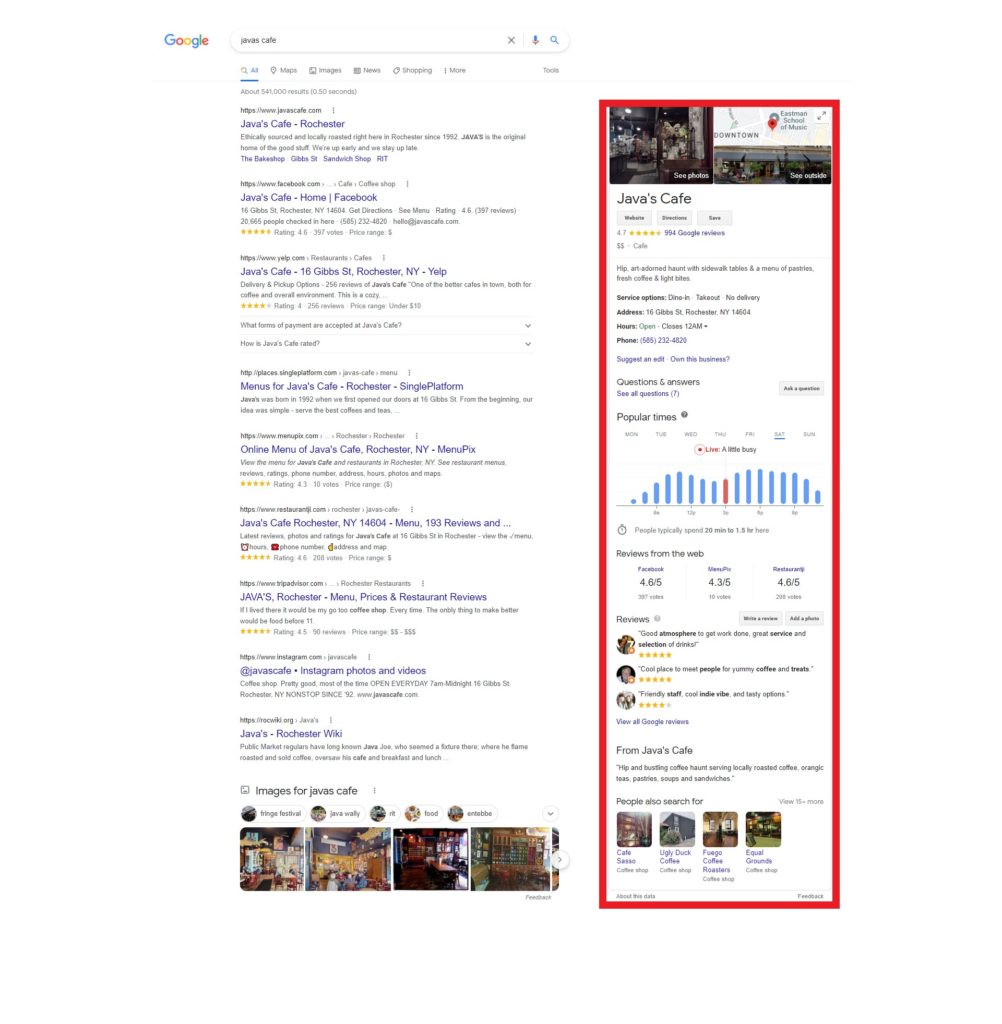Having a Business Profile on Google and managing it through your law firm’s Google My Business (GMB) account is a core component of many search engine optimization (SEO) campaigns. A Business Profile can enhance the rankings of the firm’s website and can improve the click-through-rate by being more conspicuous in the search engine results page (SERP).
Unfortunately, Business Profiles are not static pages that can set up and forgotten about. They have to be updated. If they aren’t, Google’s algorithms will see them as stale and their SEO potency and traffic will depreciate.
GMB Accounts and Business Profiles
We’re talking about Business Profiles here, like the one in the red box on the right:

Anyone can create one for a business, including non-owners like clients, fans, or competitors. Needless to say, this makes it important to get ahead of the game and make one for your own firm. To do this, or to manage the information on a Business Profile that was created by someone else, you need a Google My Business account.
Once this is set up, you can track the traffic that your site gets through your Business Profile by using a UTM code in the listing. To do this, you can use the campaign URL builder in Google’s Developer Tools.
Everything is Set Up and Traffic Was Flowing In, But Now It Isn’t
Law firms that set up a Business Profile and populate it with optimized content are likely to see a nice flow of traffic to the site coming from the display in the sidebar and in the local box. However, firms that don’t continue to manage their Profile may start to see the traffic decrease over time.

There are a few things that could have happened.
Google’s Algorithms Frown on a Lack of Updates
Google’s business model is to provide relevant and important search results in order to keep searchers satisfied so that the company can then capitalize on their traffic by selling ad space.
A relevant and important piece of information about a business is whether it is still open or not. Unfortunately, Google’s algorithms are (in our opinion) a bit aggressive in making this determination. They could rely on input from the business owner, who could self-report that the business has shut down, or on feedback from clients or customers, who are fairly reliable when it comes to reporting that a business has closed its doors. However, there is strong evidence that Google’s algorithms steadily demote Business Profiles that are not active on the platform.
We think that this is a somewhat self-interested maneuver on Google’s part to create activity on the platform by coercing businesses into adding content and engaging with users.
Fair or not, law firms may see their GMB traffic decline over time if they do not play the game. Law firms should consider:
- Responding to all of the Google reviews that come in
- Urge satisfied clients to leave a Google review
- Add photos
- Promptly answer any questions that get asked on the Business Profile
- Publish GMB posts (which may indirectly boost your SEO)
However, if the decline in traffic was sudden and severe, rather than a slow dip, something else may be amiss.
Something May Have Broken
If the traffic coming to your law firm’s site from its Google Business Profile dropped off a cliff, though, it is unlikely to be a simple lack of updates. Something deeper may be the culprit, and the only way to find out what went wrong is through some troubleshooting.
The first place to start is the UTM code that tracks what traffic comes to your site from its GMB listings. If the tracking code breaks, the GMB traffic no longer gets differentiated from the other traffic sources. A UTM code can break if the marketing campaign is changed or if the destination page moved and no redirect was provided.
Also take a look at any changes that were made to the Business Profile in the weeks or month before the drop. If a user recommended information that was inaccurate, like a different address on the other side of the state, it can confuse the search engine’s algorithms. We’re not saying that competitors do this sort of thing. We’re just recommending that you double-check your contact and geographical information.
A far worse possibility is a manual penalty. If Google decides that your site is violating the search engine’s guidelines, it can impose a manual penalty and delist the entire site from the SERP, including the GMB assets. However, this is quite rare.
One way to pinpoint the problem is to look at the other data you have about your site’s traffic. Are other forms of traffic down as well? Is your site’s upload speed still good?
You should also check your competition. Some of your GMB traffic will come from your firm’s listing in the local SEO box. If a competing firm has stepped up its marketing game, their gains can come at your expense.